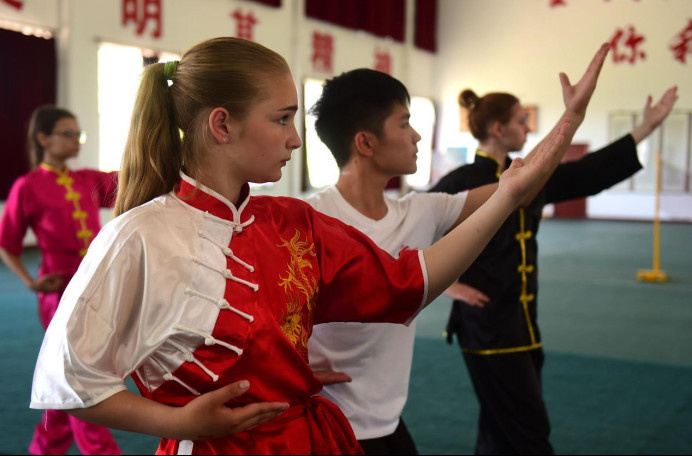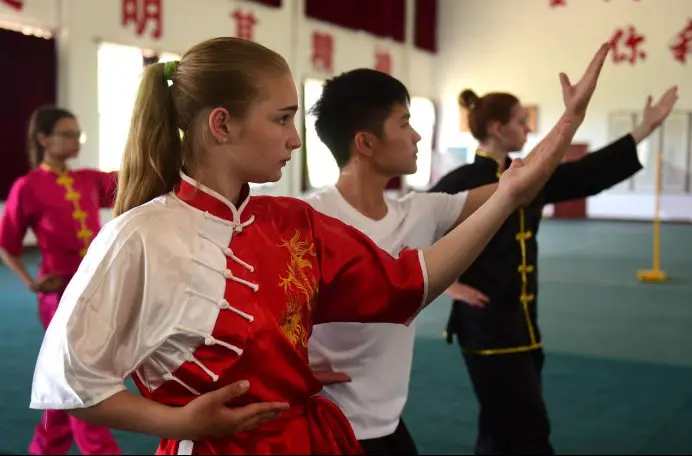By Bao Han, People's Daily

Russian teenagers practice Bajiquan, a traditional martial art, under the instruction of a master in a training base in Cangzhou, north China's Hebei province. (Photo by Fu Xinchun/People's Daily Online)
Soaring kicks, side flips, spinning kicks... A set of smooth, flowing movements combining strength and grace fully demonstrated the stretch, elegance and fluidity of Changquan.
On Sept. 24, the men's Changquan final of Wushu was held at the Xiaoshan Guali Sports Center in Hangzhou, east China's Zhejiang province, during the 19th Asian Games. Chinese athlete Sun Peiyuan successfully defended his title.
After standing on the top podium in Incheon in 2014 and in Jakarta in 2018, Sun once again gained the laurel at the Asian Games, achieving a three-peat.
On the same day, the women's Taijiquan and Taijijian all-round final kicked off. Competing in the Asian Games for the first time, Chinese young athlete Tong Xin clinched the gold medal with top scores in both Taijiquan and Taijijian.
Scoring two golds a day, the Chinese national Wushu team showcased the charm of Wushu, or Chinese martial arts, to the world.
Wushu, originating from China, is a traditional sport that focuses on routines and combat. As a treasure of the 5,000-year-old Chinese civilization, it emphasizes mastery of physical forms while conveying inner spirit, unifying internal cultivation and external technique. This unique integration is of high aesthetic beauty.
As a competitive sport with great fitness value, Wushu has spread widely across Asia and the world at large. Since it was first incorporated into the Beijing Asian Games in 1990, the event has attracted massive athletes from countries and regions in Asia. It also appeared as a special exhibition event at the 2008 Beijing Olympics.
Wushu is blossoming around the world. In recent years, leveraging international comprehensive event platforms like the Asian Games, the FISU World University Games and the World Games, traditional Chinese Wushu has gained countless popularity overseas.
A global fever for Wushu has emerged, attracting numerous young people to travel to China for training. Additionally, many Chinese have established Wushu schools outside China, providing people from diverse cultural backgrounds the opportunity to experience the charm of the sport.
A total of 158 countries and regions have now united under the banner of the International Wushu Federation, and there are over 100 million Wushu enthusiasts worldwide. A complete, standardized competition system of the sport has been shaped, which covers such tournaments or events as the World Wushu Championships, the World Taijiquan Championships and the World Junior Wushu Championships.
More people will be able to appreciate the beauty of Wushu during the Hangzhou Asian Games. It is expected that people from more countries would get to know, experience and fall in love with Wushu, which will help this cultural gem of China shine brighter.
On Sept. 24, the men's Changquan final of Wushu was held at the Xiaoshan Guali Sports Center in Hangzhou, east China's Zhejiang province, during the 19th Asian Games. Chinese athlete Sun Peiyuan successfully defended his title.
After standing on the top podium in Incheon in 2014 and in Jakarta in 2018, Sun once again gained the laurel at the Asian Games, achieving a three-peat.
On the same day, the women's Taijiquan and Taijijian all-round final kicked off. Competing in the Asian Games for the first time, Chinese young athlete Tong Xin clinched the gold medal with top scores in both Taijiquan and Taijijian.
Scoring two golds a day, the Chinese national Wushu team showcased the charm of Wushu, or Chinese martial arts, to the world.
Wushu, originating from China, is a traditional sport that focuses on routines and combat. As a treasure of the 5,000-year-old Chinese civilization, it emphasizes mastery of physical forms while conveying inner spirit, unifying internal cultivation and external technique. This unique integration is of high aesthetic beauty.
As a competitive sport with great fitness value, Wushu has spread widely across Asia and the world at large. Since it was first incorporated into the Beijing Asian Games in 1990, the event has attracted massive athletes from countries and regions in Asia. It also appeared as a special exhibition event at the 2008 Beijing Olympics.
Wushu is blossoming around the world. In recent years, leveraging international comprehensive event platforms like the Asian Games, the FISU World University Games and the World Games, traditional Chinese Wushu has gained countless popularity overseas.
A global fever for Wushu has emerged, attracting numerous young people to travel to China for training. Additionally, many Chinese have established Wushu schools outside China, providing people from diverse cultural backgrounds the opportunity to experience the charm of the sport.
A total of 158 countries and regions have now united under the banner of the International Wushu Federation, and there are over 100 million Wushu enthusiasts worldwide. A complete, standardized competition system of the sport has been shaped, which covers such tournaments or events as the World Wushu Championships, the World Taijiquan Championships and the World Junior Wushu Championships.
More people will be able to appreciate the beauty of Wushu during the Hangzhou Asian Games. It is expected that people from more countries would get to know, experience and fall in love with Wushu, which will help this cultural gem of China shine brighter.
 Menu
Menu
 Unleashing charm of Wushu at Hangzhou Asian Games
Unleashing charm of Wushu at Hangzhou Asian Games
















